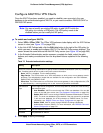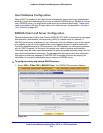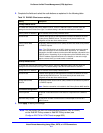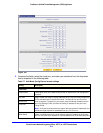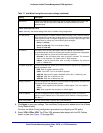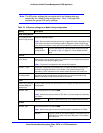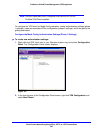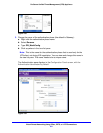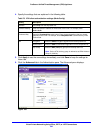
Virtual Private Networking Using IPSec, PPTP, or L2TP Connections
315
ProSecure Unified Threat Management (UTM) Appliance
4. Click Apply to save your settings. The new Mode Config record is added to the List of Mode
Config Records table.
Continue the Mode Config configuration procedure by configuring an IKE policy.
5. Select VPN > IPSec VPN. The IPSec VPN submenu tabs display with the IKE Policies
screen in view (see Figure 179 on page 293).
DNS Server Enter the IP address of the DNS server that is used by remote VPN clients in the
Primary field. You can enter the IP address of a second DNS server in the
Secondary field.
Traffic Tunnel Security Level
Note: Generally, the default settings work well for a Mode Config configuration.
PFS Key Group Select this check box to enable Perfect Forward Secrecy (PFS), and then select a
Diffie-Hellman (DH) group from the drop-down list. The DH Group sets the strength
of the algorithm in bits. The higher the group, the more secure the exchange. From
the drop-down list, select one of the following three strengths:
• Group 1 (768 bit)
• Group 2 (1024 bit). This is the default setting.
• Group 5 (1536 bit)
SA Lifetime The lifetime of the security association (SA) is the period or the amount of
transmitted data after which the SA becomes invalid and needs to be renegotiated.
From the drop-down list, select how the SA lifetime is specified:
• Seconds. In the SA Lifetime field, enter a period in seconds. The minimum
value is 300 seconds. The default value is 3600 seconds.
• KBytes. In the SA Lifetime field, enter a number of kilobytes. The minimum
value is 1920000 KB.
Encryption Algorithm From the drop-down list, select one of the following five algorithms to negotiate the
security association (SA):
• DES. Data Encryption Standard (DES).
• 3DES. Triple DES. This is the default algorithm.
• AES-128. Advanced Encryption Standard (AES) with a 128-bit key size.
• AES-192. AES with a 192-bit key size.
• AES-256. AES with a 256-bit key size.
Integrity Algorithm From the drop-down list, select one of the following two algorithms to be used in the
VPN header for the authentication process:
• SHA-1. Hash algorithm that produces a 160-bit digest. This is the default
setting.
• MD5. Hash algorithm that produces a 128-bit digest.
Local IP Address The local IP address to which remote VPN clients have access. If you do not
specify a local IP address, the UTM’s default LAN IP address is used (by default,
192.168.1.1).
Local Subnet Mask The local subnet mask. Typically, this is 255.255.255.0.
Table 77. Add Mode Config Record screen settings (continued)
Setting Description





